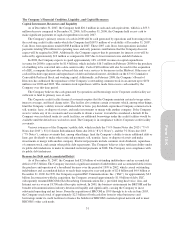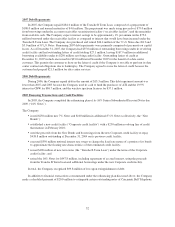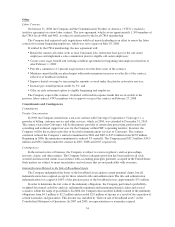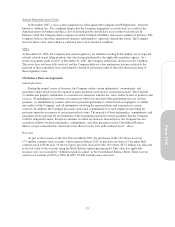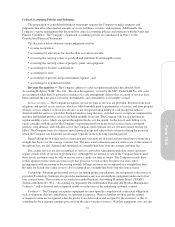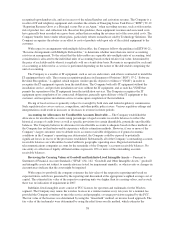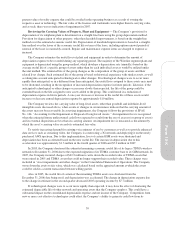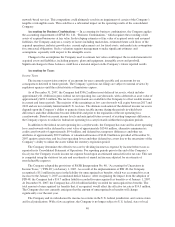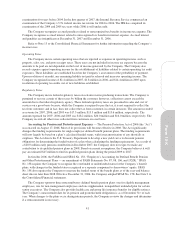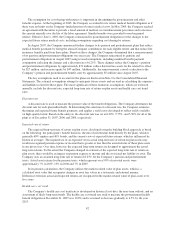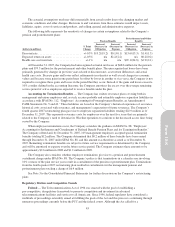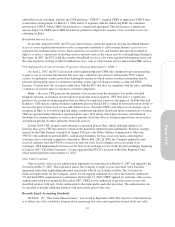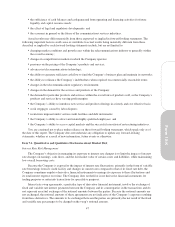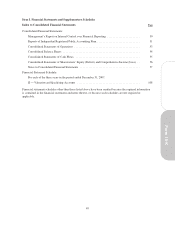Cincinnati Bell 2007 Annual Report Download - page 119
Download and view the complete annual report
Please find page 119 of the 2007 Cincinnati Bell annual report below. You can navigate through the pages in the report by either clicking on the pages listed below, or by using the keyword search tool below to find specific information within the annual report.
present value of royalty expense that could be avoided in the operating business as a result of owning the
respective asset or technology. The fair value of the licenses and trademarks were higher than its carrying value,
and as such, there was no indication of impairment in 2007.
Reviewing the Carrying Values of Property, Plant and Equipment — The Company’s provision for
depreciation of its telephone plant is determined on a straight-line basis using the group depreciation method.
Provision for depreciation of other property, other than leasehold improvements, is based on the straight-line
method over the estimated economic useful life. Depreciation of leasehold improvements is based on a straight-
line method over the lesser of the economic useful life or term of the lease, including option renewal periods if
renewal of the lease is reasonably assured. Repairs and maintenance expense items are charged to expense as
incurred.
The Company estimates the useful lives of plant and equipment in order to determine the amount of
depreciation expense to be recorded during any reporting period. The majority of the Wireline segment plant and
equipment is depreciated using the group method, which develops a depreciation rate (annually) based on the
average useful life of a specific group of assets rather than for each individual asset as would be utilized under
the unit method. The estimated life of the group changes as the composition of the group of assets and their
related lives change. Such estimated life of the group is based on historical experience with similar assets, as well
as taking into account anticipated technological or other changes. If technological changes were to occur more
rapidly than anticipated, or in a different form than anticipated, the useful lives assigned to these assets may need
to be shortened, resulting in the recognition of increased depreciation expense in future periods. Likewise, if the
anticipated technological or other changes occur more slowly than expected, the life of the group could be
extended based on the life assigned to new assets added to the group. This could result in a reduction of
depreciation expense in future periods. A one-year decrease or increase in the useful life of these assets would
increase or decrease annual depreciation expense by approximately $10 million.
The Company reviews the carrying value of long-lived assets, other than goodwill and indefinite-lived
intangible assets discussed above, when events or changes in circumstances indicate that the carrying amount of
the assets may not be recoverable. In assessing impairments, the Company follows the provisions of SFAS
No. 144, “Accounting for the Impairment or Disposal of Long-Lived Assets.” An impairment loss is recognized
when the estimated future undiscounted cash flows expected to result from the use of an asset (or group of assets)
and its eventual disposition are less than its carrying amount. An impairment loss is measured as the amount by
which the asset’s carrying value exceeds its estimated fair value.
To satisfy increasing demand for existing voice minutes of use by customers as well as to provide enhanced
data services such as streaming video, the Company is constructing a 3G network and deploying it on the newly
purchased AWS spectrum. Due to this implementation, lives of certain GSM assets were shortened and
depreciation has been accelerated based on the new useful life. The increase in depreciation due to this
acceleration was approximately $1.3 million in the fourth quarter of 2006 and $5.2 million in 2007.
In 2003, the Company shortened the estimated remaining economic useful life of its legacy TDMA wireless
network to December 31, 2006 due to the expected migration of its TDMA customer base to its GSM network. In
2005, the Company incurred charges of $42.3 million to write down the recorded value of TDMA assets that
were retired in 2005 and TDMA assets that could no longer support their recorded value. These charges were
included in “Asset impairments and other charges” in the Consolidated Statement of Operations. The Company
wrote down the assets to fair value, which was calculated based on the appraised amount at which the assets
could be sold in a current transaction between willing parties.
Also, in 2005, the useful life of certain of the remaining TDMA assets was shortened from the
December 31, 2006 date being used, and depreciation was accelerated. The change in depreciation expense due
to the change in estimate in the second quarter decreased 2005 operating income by $7.7 million.
If technological changes were to occur more rapidly than expected, it may have the effect of shortening the
estimated depreciable life of other network and operating assets that the Company employs. This could have a
substantial impact on the consolidated depreciation expense and net income of the Company. Competition from
new or more cost effective technologies could affect the Company’s ability to generate cash flow from its
39
Form 10-K




